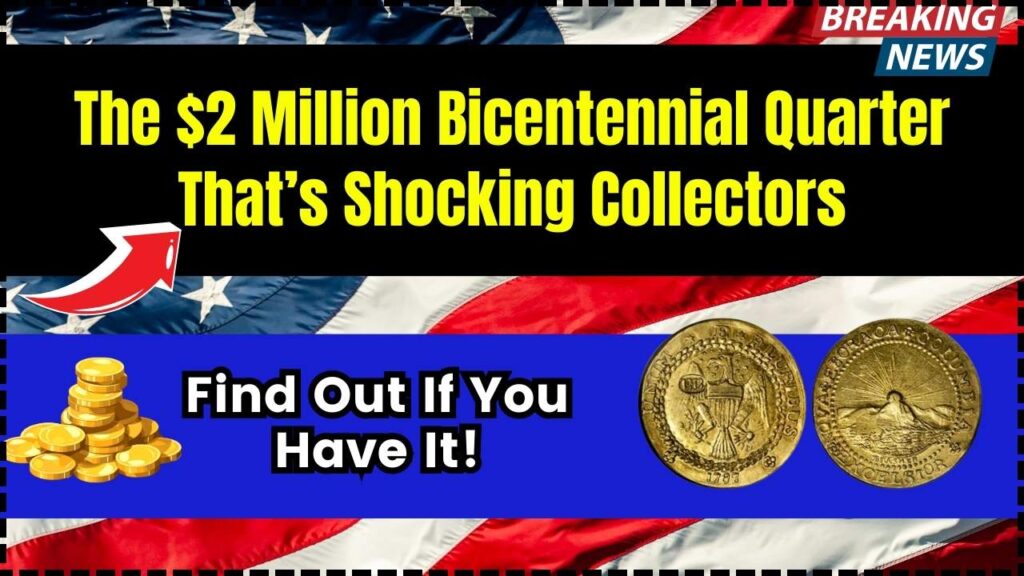The $2 Million Bicentennial Quarter That’s Shocking Collectors: When people talk about rare coins, few things grab attention quite like the phrase: “The $2 million Bicentennial Quarter.” It sounds too good to be true, right? A 25-cent coin worth millions? Yet, this intriguing headline has swept through collector communities, numismatic circles, and social media feeds like wildfire, leaving many people rummaging through their change jars and old coin collections, wondering if they might unknowingly be holding a small fortune.

Let’s break it down professionally and clearly: Is the $2 million Bicentennial quarter real, and if so, what makes it so valuable? Whether you’re a casual hobbyist, a beginner collector, or an experienced numismatist with decades of experience, understanding the value, rarity, and true market dynamics behind this coin is essential. This article will guide you through all the facts, debunk the myths, and help you understand exactly what to look for in your pocket change.
The $2 Million Bicentennial Quarter That’s Shocking Collectors
| Topic | Details |
|---|---|
| Coin Type | 1976 Bicentennial Quarter (1776-1976 dual date) |
| Claim to Fame | Rumored $2 million value for rare versions |
| Mint Varieties | Philadelphia (no mint mark), Denver (“D”), San Francisco (“S”) |
| Composition | Mostly copper-nickel; some 40% silver collector editions |
| Most Valuable Versions | Errors, high grades (MS-67+), 40% silver proofs |
| Verified High Auction Price | Up to $19,200 for MS-68 1976-S Silver Proof Source: PCGS |
| Learn More | U.S. Mint Official Site |
The 1976 Bicentennial quarter is an enduring symbol of American history and pride. While the story of a $2 million version may be more legend than fact, certain coins from this series are indeed worth far more than 25 cents. From rare errors and high mint state grades to silver proof strikes, there are real opportunities for value if you know what to look for.
If you come across one in excellent condition or bearing a unique feature, it might be worth investigating. And who knows? That coin in your drawer could turn out to be one of the few shining stars of American numismatics.
The Truth About the Bicentennial Quarter
The Bicentennial quarter was created as part of a special release to celebrate the 200th anniversary of the Declaration of Independence in 1976. Unlike the standard Washington quarter, which typically features a bald eagle on the reverse, this commemorative edition stands out with a Colonial drummer boy design on the back, symbolizing American patriotism and the spirit of the Revolutionary War.
These quarters were released in both business strike and proof versions and were minted in large quantities—over 1.7 billion were produced across three mints. Despite this, select versions of the coin have become highly desirable due to unique features that make them stand out from the crowd.
Why Are Some Bicentennial Quarters Valuable?
Although the majority of Bicentennial quarters are still only worth their face value, there are key attributes that can drastically increase their worth:
- Rare Mint Errors: These include double die obverses, off-center strikes, and coins struck on the wrong planchet. Minting errors are rare and often result from unexpected issues during the production process.
- Silver Content: Special collector sets contained coins made from 40% silver. These sets were sold by the U.S. Mint and not released into general circulation, making them more exclusive and valuable.
- Grade and Condition: Coins in pristine, uncirculated condition can be worth far more than circulated ones. Grades like MS-67, MS-68, or PR70DCAM can add hundreds or even thousands to a coin’s value.
Identify a Valuable Bicentennial Quarter
Spotting a potentially rare and valuable quarter isn’t rocket science, but it does require some attention to detail. Here’s a detailed guide to help you assess your coins:
- Check the Mint Mark: You can find the mint mark just below Washington’s ponytail on the obverse (heads) side,
- No mint mark = Minted in Philadelphia
- “D” = Minted in Denver
- “S” = Minted in San Francisco (usually proof or silver issues)
- The “S” mint mark is your first big clue that the coin might be a silver edition from a collector’s set.
- Examine the Material and Edge:
- Copper-Nickel Quarters: These are standard circulation coins with a brownish or reddish stripe along the edge.
- 40% Silver Quarters: These coins have a uniform silvery edge with no visible copper streak. They also weigh slightly more—approximately 5.75 grams versus 5.67 grams for copper-nickel versions.
- Look Closely for Errors: Some valuable minting errors include,
- Double Die Obverse: Slight duplication of images or text, especially on the date or “IN GOD WE TRUST.”
- Off-Center Strike: If the design is shifted off the center of the coin, it may be an error worth investigating.
- Wrong Planchet Errors: Occasionally, coins are struck on blanks meant for other denominations. These are very rare and can be worth thousands.
- Grade the Coin Professionally: Even without errors, a Bicentennial quarter can be valuable if it’s in exceptional condition. Consider submitting your coin to one of these professional grading companies:
- A coin graded MS-67, MS-68, or PR70DCAM indicates near-flawless quality and can significantly increase market value.
Examples of High-Value Bicentennial Quarters
To better understand what gives these coins their value, here are real-world examples of quarters that have sold for impressive amounts:
- 1976-S Silver Proof Quarter PR70DCAM: This coin fetched $19,200 at auction, showcasing the upper end of the market for flawless, silver proof coins.
- 1976-D Double Die Obverse (FS-101): This rare mint error has been sold for over $3,000, especially in high grades.
- 1976 No Mint Mark MS-68: A Philadelphia business-strike quarter in this rare grade has sold for $5,000+, due to its immaculate condition and scarcity.
Busting the $2 Million Myth
Now, let’s address the elephant in the room: Is there truly a Bicentennial quarter worth $2 million? The short answer is no. No reputable auction house, grading company, or coin expert has recorded a sale even close to that figure. The $2 million claim is more of an internet rumor or exaggerated marketing tactic than a documented reality.
However, the myth has had a positive effect. It has brought attention to collectible coins and encouraged many people to explore numismatics for the first time. Even though a $2 million coin may not exist, quarters worth hundreds or thousands certainly do—and they might just be in your possession.
What To Do If You Think You Have a Valuable Quarter
If you believe you’ve found a potentially rare or valuable Bicentennial quarter, follow these steps:
- Do Not Clean the Coin: Cleaning removes natural toning and can reduce its value by up to 90%.
- Use a Loupe or Magnifying Glass: Inspect closely for any signs of doubling, misstrikes, or other anomalies.
- Weigh the Coin: A small digital scale can help determine if the coin is made of silver.
- Consult a Professional: Reach out to a coin dealer or send it in to be graded by PCGS or NGC.
- Compare Auction Results: Check Heritage Auctions and eBay for similar listings to estimate value.
The $67 Million Bicentennial Quarter and 4 Coins Worth $600K – Are You Holding Them?
These 7 Rare $2 Bills Could Be Worth Thousands in 2025 – Do You Have One?
Lincoln Wheat Penny Worth $4.2 Million — Have You Checked Your Coins Yet?
FAQs On The $2 Million Bicentennial Quarter That’s Shocking Collectors
Are all Bicentennial quarters valuable?
No. Most are still only worth face value unless they meet specific conditions like mint errors, silver composition, or pristine condition.
How many Bicentennial quarters were produced?
Over 1.7 billion were minted, including proof and business strike versions from all three major U.S. mints.
What does PR70DCAM mean?
It stands for “Proof 70 Deep Cameo,” indicating a proof coin in perfect condition with strong contrast between frosted devices and mirrored fields.
Can I find a silver Bicentennial quarter in circulation?
Unlikely. Silver versions were sold in special mint sets and weren’t released for general circulation.
How do I sell a valuable quarter?
First, get it graded. Then you can list it through a coin dealer, auction house, or an online marketplace. Verified coins command higher prices.








